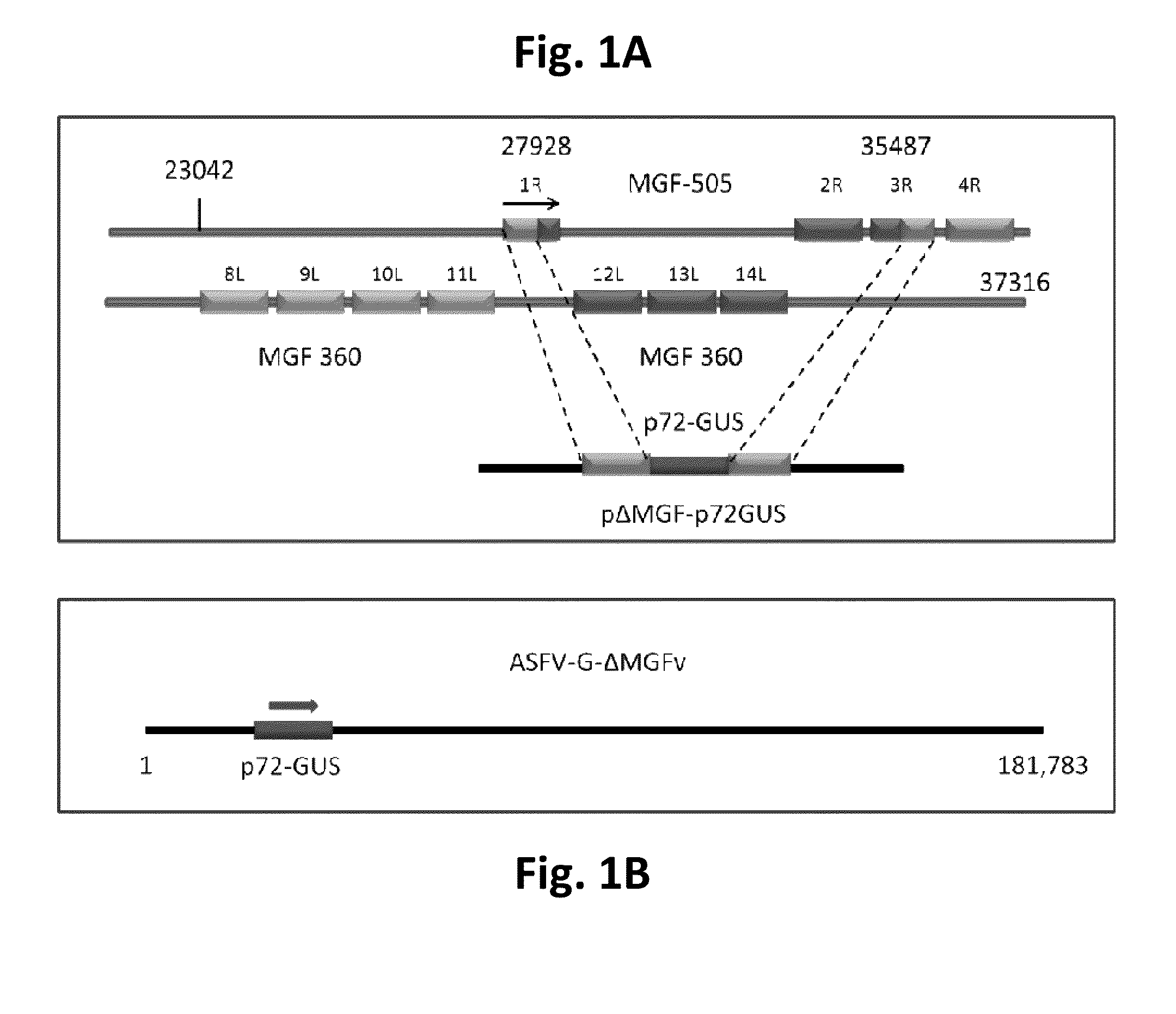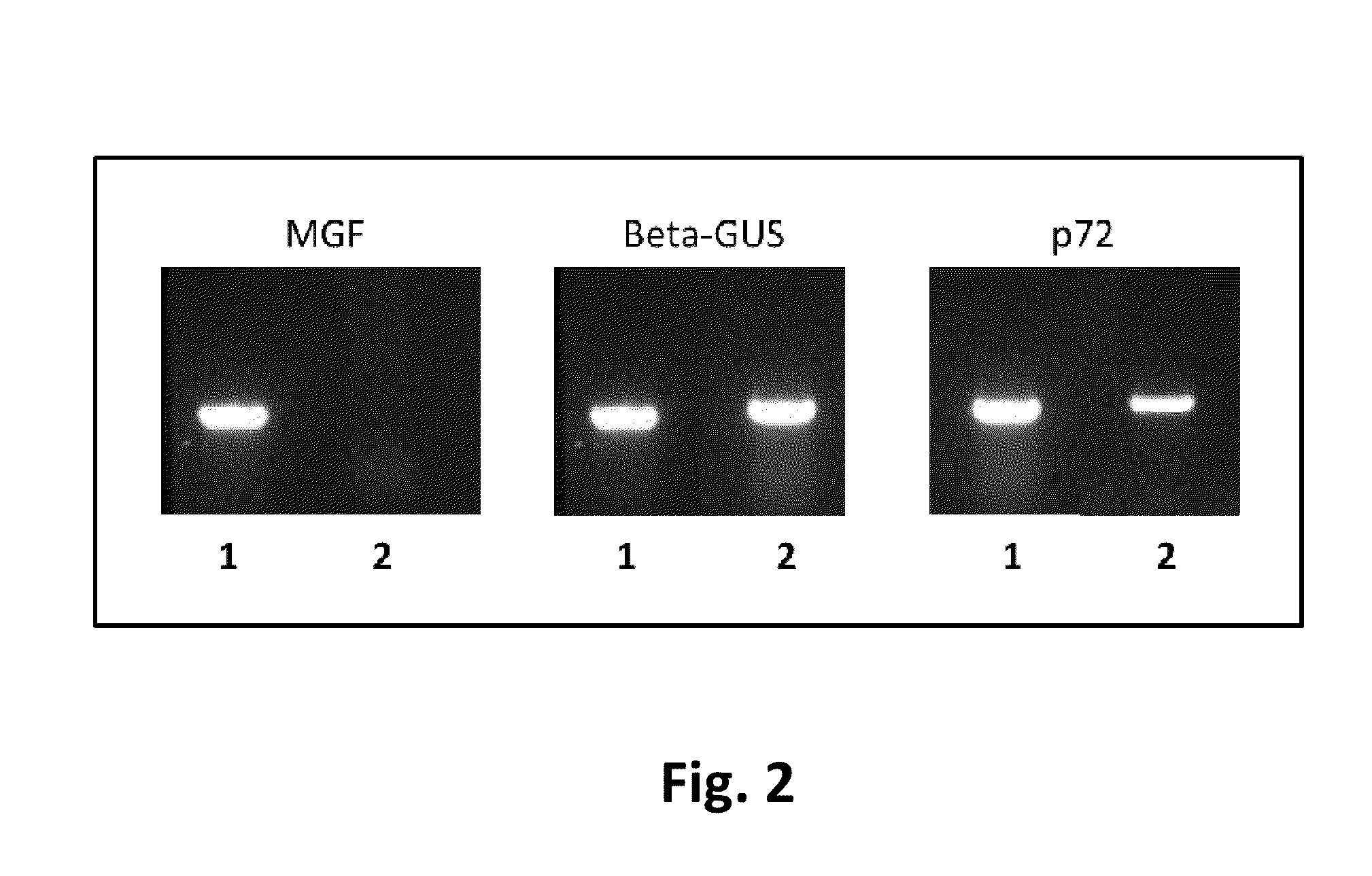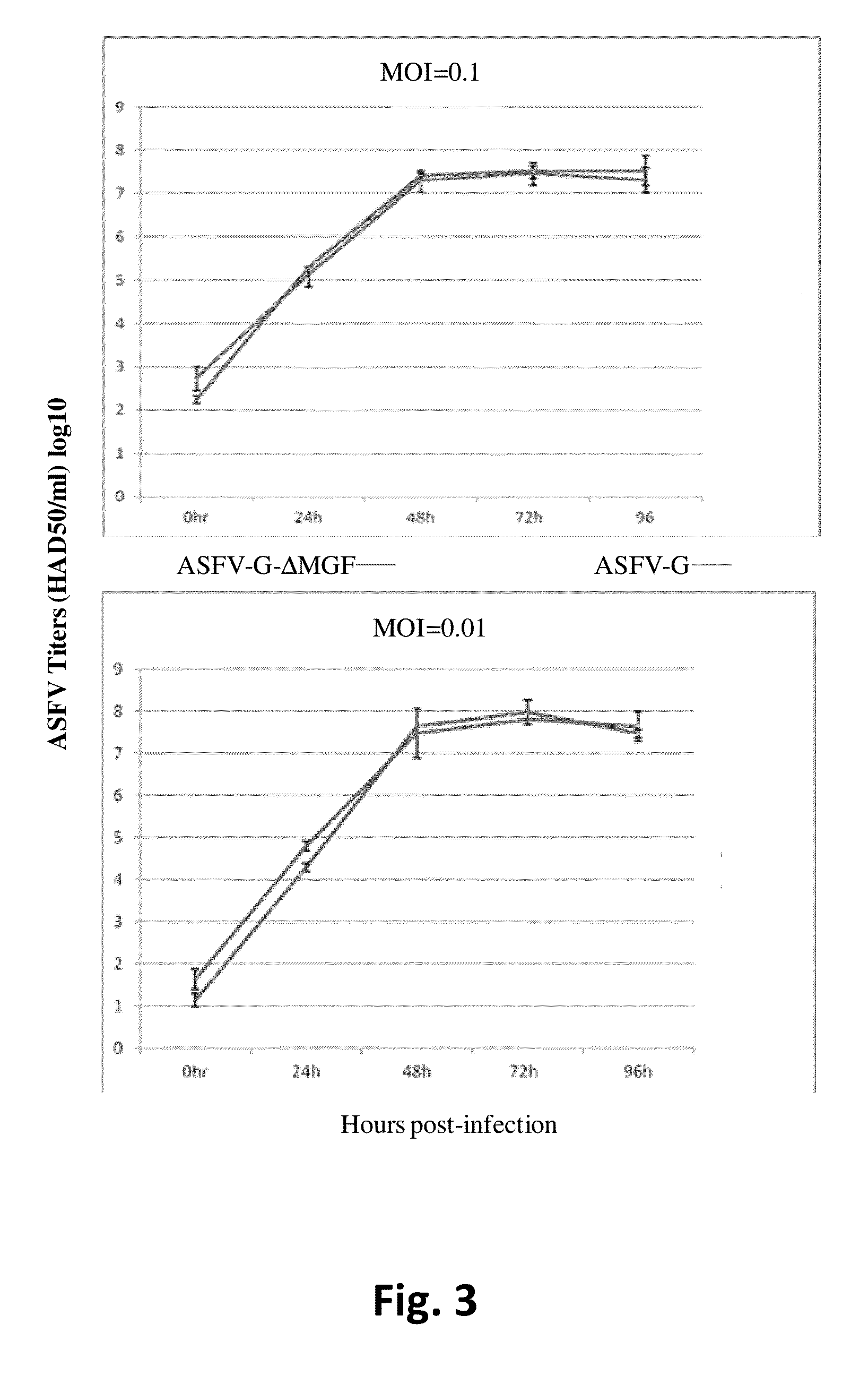Attenuated African Swine Fever Virus Vaccine Based in the Deletion of MGF Genes
a technology of attenuation and african swine fever, which is applied in the field of construction of a recombinant african swine fever virus (asfv) live attenuated candidate strain vaccine, can solve the problems of domestic pig fever, fever, hemorrhage, and the risk of further dissemination into neighbouring countries
- Summary
- Abstract
- Description
- Claims
- Application Information
AI Technical Summary
Benefits of technology
Problems solved by technology
Method used
Image
Examples
example 1
Cell Cultures and Viruses
[0036]Primary swine macrophage cell cultures were prepared from defibrinated swine blood as previously described by Zsak et al. (1996, supra). Briefly, heparin-treated swine blood was incubated at 37° C. for 1 hour to allow sedimentation of the erythrocyte fraction. Mononuclear leukocytes were separated by flotation over a Ficoll-Paque (Pharmacia, Piscataway, N.J.) density gradient (specific gravity, 1.079). The monocyte / macrophage cell fraction was cultured in plastic Primaria (Falcon; Becton Dickinson Labware, Franklin Lakes, N.J.) tissue culture flasks containing macrophage media, composed of RPMI 1640 Medium (Life Technologies, Grand Island, N.Y.) with 30% L929 supernatant and 20% fetal bovine serum (HI-FBS, Thermo Scientific, Waltham, Mass.) for 48 hours at 37° C. under 5% CO2. Adherent cells were detached from the plastic by using 10 mM EDTA in phosphate buffered saline (PBS) and were then reseeded into Primaria T25, 6- or 96-well dishes at a density o...
example 2
Construction of the Recombinant ASFV-G-ΔMGF
[0040]ASFV-G ΔMGF was constructed from the highly pathogenic ASFV Georgia 2007 isolate (ASFV-G). Recombinant ASFVs were generated by homologous recombination between the parental ASFV genome and a recombination transfer vector following infection and transfection of swine macrophage cell cultures (Neilan et al., supra; Zsak et al. 1996, supra). Recombinant transfer vector (p72GUSΔMGF) contained flanking genomic regions to MGF500 1R, and 3R genes, which included portions of MGF mapping to the left (3.3 kbp) and right (1 kbp) of the MGF500 1R, and 3R genes and a reporter gene cassette containing the β-glucuronidase (GUS) gene with the ASFV p72 late gene promoter, p72GUS (45) (FIG. 1). This construction created a 7,559-nucleotide deletion including a partial deletion of MGF500 1R, and 3R genes and complete deletion of ASFV MGF 360 genes 12L, 13, and 14L along with MGF500 2R) (FIG. 1). Recombinant transfer vector p72GUSΔMGF was obtained by DNA ...
example 3
Polymerase Chain Reaction (PCR)
[0042]The extent of purity of ASFV-G ΔMGF in the virus stock as well as in virus isolated from infected animals was assessed by PCR. Detection of the MGF genes was performed using the following pair of primers: forward 5′ CATGGAACTATTCAACGA GCAGGA 3′(SEQ ID NO:3); reverse 5′ CGCTGATCAATTCCACAGTT 3′ (SEQ ID NO:4). Detection of the β-Gus gene was performed using the following pair of primers: forward 5′GACGGCCTGTGGGCATT3′ (SEQ ID NO:5); reverse 5′GCGATGGATTC CGGCAT3′ (SEQ ID NO:6). Detection of the p72 (86460 gene was performed using the following pair of primers: forward 5′GTCTTATTGCTAACGATGGGAAG3′ (SEQ ID NO:7); reverse 5′CCAAAGGTAAGCTTGTTTCCCAA3′ (SEQ ID NO:8).
[0043]PCR products were sequenced using the dideoxynucleotide chain-termination method (Sanger et al. 1977. Proc. Natl. Acad. Sci. USA 74:5463-5467). Sequencing reactions were prepared with the Dye Terminator Cycle Sequencing Kit (Applied Biosystems, Foster City, Calif.). Reaction products were ...
PUM
| Property | Measurement | Unit |
|---|---|---|
| Volume | aaaaa | aaaaa |
| Volume | aaaaa | aaaaa |
| Volume | aaaaa | aaaaa |
Abstract
Description
Claims
Application Information
 Login to View More
Login to View More - R&D
- Intellectual Property
- Life Sciences
- Materials
- Tech Scout
- Unparalleled Data Quality
- Higher Quality Content
- 60% Fewer Hallucinations
Browse by: Latest US Patents, China's latest patents, Technical Efficacy Thesaurus, Application Domain, Technology Topic, Popular Technical Reports.
© 2025 PatSnap. All rights reserved.Legal|Privacy policy|Modern Slavery Act Transparency Statement|Sitemap|About US| Contact US: help@patsnap.com



